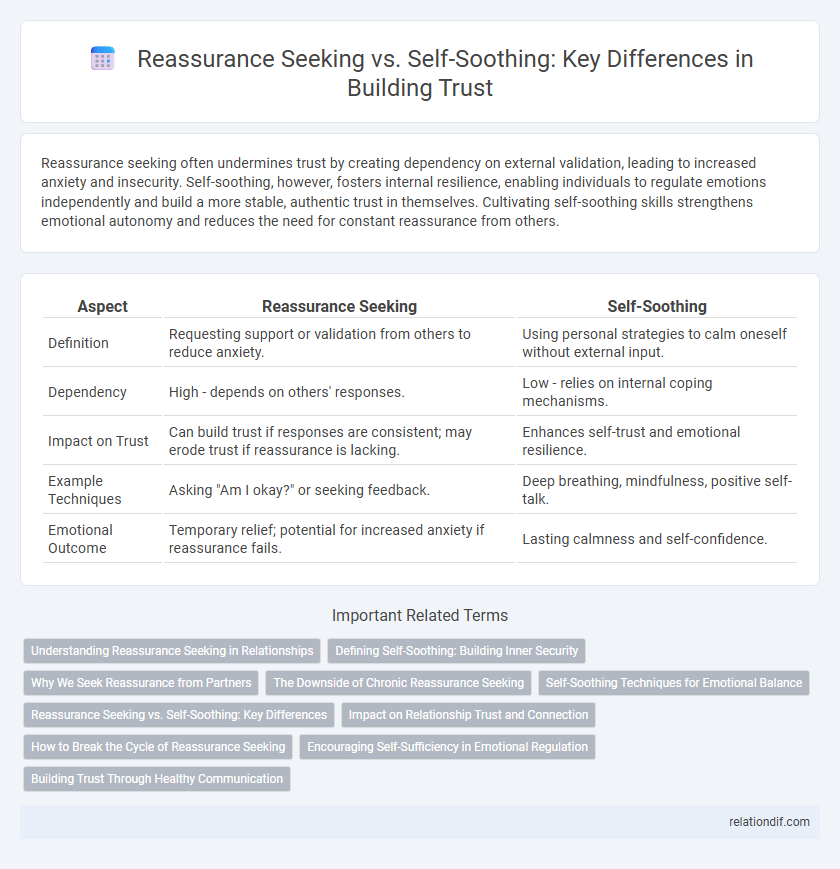Reassurance seeking often undermines trust by creating dependency on external validation, leading to increased anxiety and insecurity. Self-soothing, however, fosters internal resilience, enabling individuals to regulate emotions independently and build a more stable, authentic trust in themselves. Cultivating self-soothing skills strengthens emotional autonomy and reduces the need for constant reassurance from others.
Table of Comparison
| Aspect | Reassurance Seeking | Self-Soothing |
|---|---|---|
| Definition | Requesting support or validation from others to reduce anxiety. | Using personal strategies to calm oneself without external input. |
| Dependency | High - depends on others' responses. | Low - relies on internal coping mechanisms. |
| Impact on Trust | Can build trust if responses are consistent; may erode trust if reassurance is lacking. | Enhances self-trust and emotional resilience. |
| Example Techniques | Asking "Am I okay?" or seeking feedback. | Deep breathing, mindfulness, positive self-talk. |
| Emotional Outcome | Temporary relief; potential for increased anxiety if reassurance fails. | Lasting calmness and self-confidence. |
Understanding Reassurance Seeking in Relationships
Reassurance seeking in relationships often signals underlying anxiety and a need for external validation, which can strain trust between partners. Unlike self-soothing, which relies on internal coping mechanisms to regulate emotions, reassurance seeking depends on others to alleviate insecurity, potentially creating dependency. Building trust involves recognizing these behaviors and encouraging self-soothing techniques to foster emotional resilience and secure attachment.
Defining Self-Soothing: Building Inner Security
Self-soothing involves using internal resources to regulate emotions and maintain calm without external validation, fostering resilience and emotional independence. It contrasts with reassurance seeking, where individuals rely on others for comfort and affirmation, potentially undermining self-trust. Developing self-soothing skills strengthens inner security, promotes emotional stability, and supports long-term psychological well-being.
Why We Seek Reassurance from Partners
Seeking reassurance from partners often stems from an underlying need to reduce anxiety and validate feelings of security in the relationship. This behavior is linked to attachment styles, where individuals with anxious attachment are more prone to rely on external validation rather than self-soothing techniques. Trust strengthens when partners consistently provide reassurance, yet developing self-soothing skills fosters emotional resilience and healthier relational dynamics.
The Downside of Chronic Reassurance Seeking
Chronic reassurance seeking often undermines trust by fostering dependency on external validation rather than promoting internal confidence and emotional resilience. This pattern can reinforce anxiety and insecurity, leading to strained relationships as others may feel overwhelmed or burdened by constant requests for affirmation. Developing self-soothing techniques enhances trust in one's own judgment and emotional stability, reducing the need for repetitive reassurance.
Self-Soothing Techniques for Emotional Balance
Self-soothing techniques, such as deep breathing, mindfulness meditation, and progressive muscle relaxation, promote emotional balance by calming the nervous system and reducing anxiety symptoms. Engaging in sensory activities like listening to calming music, using aromatherapy, or practicing gentle touch can enhance self-regulation and increase feelings of safety and trust within oneself. Developing consistent self-soothing habits strengthens resilience and decreases reliance on external reassurance, fostering greater emotional independence.
Reassurance Seeking vs. Self-Soothing: Key Differences
Reassurance seeking involves frequently asking others for validation to alleviate anxiety, which can create dependency and hinder emotional growth. Self-soothing relies on internal strategies like deep breathing or positive self-talk to manage stress independently, promoting resilience and self-trust. Understanding these key differences highlights the importance of cultivating self-soothing techniques to develop healthier, more sustainable trust in oneself.
Impact on Relationship Trust and Connection
Reassurance seeking often undermines relationship trust by creating dependency and fostering insecurity, which can erode emotional connection over time. In contrast, self-soothing promotes emotional regulation and resilience, strengthening trust and deepening intimacy between partners. Consistent self-soothing behaviors help maintain stable communication and mutual confidence, essential for long-term relationship health.
How to Break the Cycle of Reassurance Seeking
Breaking the cycle of reassurance seeking involves cultivating self-soothing techniques such as mindfulness, deep breathing, and positive self-talk to build internal trust rather than relying on external validation. Establishing clear boundaries with others and gradually reducing the frequency of seeking reassurance helps reinforce self-confidence and emotional independence. Consistent practice of these strategies promotes a shift from dependence on others to a secure sense of self-trust and emotional resilience.
Encouraging Self-Sufficiency in Emotional Regulation
Encouraging self-sufficiency in emotional regulation fosters resilience by reducing reliance on reassurance seeking, which can undermine personal confidence and trust in oneself. Developing self-soothing techniques like mindfulness, deep breathing, and positive self-talk equips individuals with tools to manage distress independently and build emotional stability. Promoting autonomy in emotional management enhances trust in one's own abilities, leading to healthier relationships and greater psychological well-being.
Building Trust Through Healthy Communication
Reassurance seeking often undermines trust by creating dependency and signaling insecurity, while self-soothing fosters emotional regulation and confidence. Building trust through healthy communication involves expressing needs clearly and managing fears internally without excessive validation requests. Consistent self-soothing techniques help maintain stable interactions, promoting mutual respect and genuine trust development.
Reassurance seeking vs self-soothing Infographic

 relationdif.com
relationdif.com